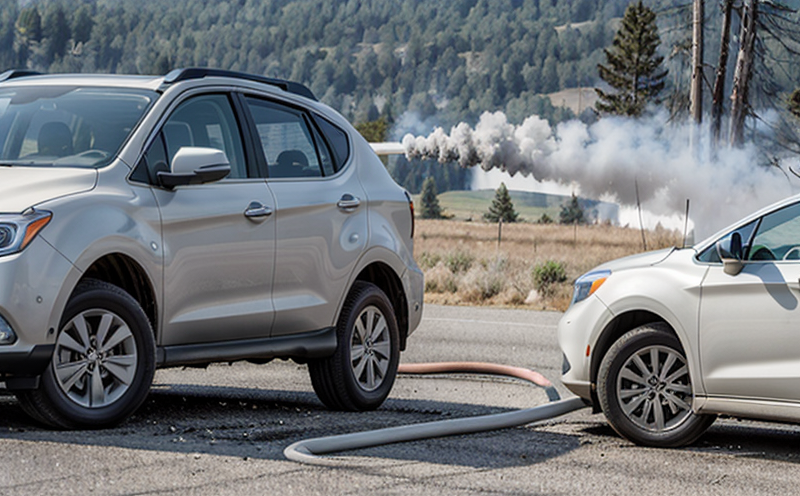Simulation of Smoke Propagation in Vehicles and Cabins
The simulation of smoke propagation in vehicles and cabins is a critical testing procedure aimed at assessing the behavior and impact of smoke under controlled conditions. This test is essential for ensuring fire safety standards are met, particularly in enclosed spaces such as vehicles, buses, trains, and other enclosed transportation systems.
Smoke density and toxic gas emission tests evaluate how materials behave when exposed to high temperatures during a fire or other thermal events. The purpose of these simulations is not only to protect the occupants but also to minimize damage to the vehicle itself. By understanding smoke behavior in various scenarios, manufacturers can design safer vehicles with better smoke control systems.
The test involves simulating real-world conditions that might be encountered in an enclosed space during a fire event. This includes testing different materials used in the construction of the cabin or vehicle components for their smoke and toxic gas emissions. The testing process helps identify potential hazards early on, allowing manufacturers to make necessary adjustments before products reach the market.
The simulation typically involves placing test specimens in a controlled environment where they are exposed to heat sources that mimic fire conditions. Sensors measure various parameters such as temperature, smoke density, and toxic gas concentrations within specific time intervals. The collected data provides insights into how effectively materials prevent or mitigate smoke accumulation inside vehicles.
It is important to note that this testing aligns with international standards like ISO 12219-1:2020, which specifies the procedure for determining smoke production rates and other relevant metrics during a fire scenario. Compliance with such standards ensures that tests are conducted consistently across industries worldwide.
Understanding the results of these simulations can help improve vehicle safety features significantly. For instance, knowing how quickly smoke accumulates in certain areas allows engineers to optimize ventilation systems or develop new materials that reduce smoke production.
The simulation also helps identify vulnerabilities within existing designs early on, enabling timely modifications and improvements before products reach end-users. This proactive approach contributes to enhancing overall public safety by reducing risks associated with fire incidents involving enclosed spaces like vehicles and cabins.
Scope and Methodology
| Parameter | Description |
|---|---|
| Test Specimens | Different types of materials commonly found in vehicle cabins. |
| Heat Source | A calibrated furnace to simulate fire conditions. |
| Sensors | For measuring temperature, smoke density, and toxic gas concentrations. |
| Test Procedure | Details |
|---|---|
| Preparation of Specimens | Cleaning and positioning the specimens within the test chamber. |
| Initiation of Heat Source | Raising the temperature to specified levels over a controlled period. |
| Data Collection | Continuous monitoring using sensors throughout the entire process. |
The test procedure begins with preparing specimens, which involves cleaning and positioning them appropriately within the testing chamber. Once this is done, a calibrated heat source is initiated to raise temperatures gradually until they reach predefined levels. Throughout this process, continuous monitoring using various sensors ensures accurate data collection.
After completing the simulation, all collected data are analyzed thoroughly against established criteria. This analysis helps determine whether each material meets specified standards regarding smoke density and toxic gas emissions. Based on these results, manufacturers can make informed decisions about selecting safer materials for future products.
Benefits
Performing simulations of smoke propagation in vehicles and cabins offers numerous benefits that contribute to enhanced fire safety measures:
Identifies hazardous conditions early on, allowing manufacturers to address them promptly.
Safeguards occupants by providing better protection against inhalation risks associated with smoke exposure.
Reduces overall vehicle damage by minimizing smoke accumulation inside enclosed spaces.
Aids in compliance with international standards, ensuring consistent quality across different regions.
Improves design and development processes through detailed insights into material performance under extreme conditions.
In summary, these simulations play a crucial role in safeguarding public health and safety while promoting safer transportation solutions. By investing time and resources into conducting such tests early in the product lifecycle, manufacturers can significantly enhance overall vehicle fire safety.
Why Choose This Test
Comprehensive evaluation of smoke density and toxic gas emissions from various materials used in vehicles.
Alignment with international standards ensuring consistent quality across different regions.
Early detection of potential hazards, enabling timely modifications to designs.
Promotion of safer transportation solutions through enhanced fire safety measures.
In-depth analysis providing valuable insights for improving future product iterations.
Selecting this test ensures that manufacturers meet stringent safety requirements while continuously striving towards creating more resilient and safe vehicles. The detailed results obtained from these simulations empower decision-makers to implement effective fire safety strategies effectively.





